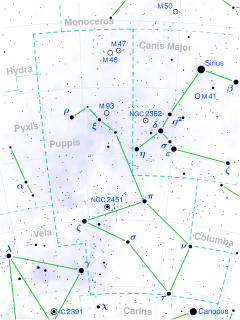
Summary
HD 57197, also known as M Puppis or HR 2789, is a suspected astrometric binary[13] located in the southern constellation Puppis, the poop deck. It has an apparent magnitude of 5.84,[2] making it faintly visible to the naked eye under ideal conditions. Based on parallax measurements from the Gaia satellite, the system is estimated to be 629 light years away from the Solar System.[1] The value is poorly constrained, but it appears to be receding with a heliocentric radial velocity of 13 km/s.[5] At its current distance, HD 57197's brightness is diminished by 0.3 magnitudes due to interstellar dust.[14] It has an absolute magnitude of -0.43.[6]
| Observation data Epoch J2000 Equinox J2000 | |
|---|---|
| Constellation | Puppis |
| Right ascension | 07h 18m 04.24932s[1] |
| Declination | −43° 59′ 12.4288″[1] |
| Apparent magnitude (V) | 5.84±0.01[2] |
| Characteristics | |
| Spectral type | B8 II/III[3] |
| U−B color index | −0.47[4] |
| B−V color index | −0.14[4] |
| Astrometry | |
| Radial velocity (Rv) | 13±10[5] km/s |
| Proper motion (μ) | RA: −9.483 mas/yr[1] Dec.: −5.396 mas/yr[1] |
| Parallax (π) | 5.1842 ± 0.0442 mas[1] |
| Distance | 629 ± 5 ly (193 ± 2 pc) |
| Absolute magnitude (MV) | −0.43[6] |
| Details | |
| Mass | 3.08[7] M☉ |
| Radius | 3.9±0.2[8] R☉ |
| Luminosity | 234[9] L☉ |
| Surface gravity (log g) | 3.77[7] cgs |
| Temperature | 12,596[9] K |
| Metallicity [Fe/H] | −0.18[7] dex |
| Age | 220[10] Myr |
| Other designations | |
| Database references | |
| SIMBAD | data |
The visible component has a stellar classification of B8 II/III, indicating that it is an evolved B-type star with the blended luminosity class of a bright giant and a giant star. HD 57197 is estimated to be 220 million years old,[10] enough time for it to expand to 3.9 times the Sun's radius.[8] It has 3.08 times the mass of the Sun[7] and radiates 234 times the luminosity of the Sun from its photosphere at an effective temperature of 12,596 K,[9] giving it a bluish-white hue. Based on its extinction in the Gaia passband, it has an iron abundance 66% that of the Sun.[7] This makes HD 57197 metal deficient.
References edit
- ^ a b c d e Vallenari, A.; et al. (Gaia collaboration) (2023). "Gaia Data Release 3. Summary of the content and survey properties". Astronomy and Astrophysics. 674: A1. arXiv:2208.00211. Bibcode:2023A&A...674A...1G. doi:10.1051/0004-6361/202243940. S2CID 244398875. Gaia DR3 record for this source at VizieR.
- ^ a b Høg, E.; Fabricius, C.; Makarov, V. V.; Urban, S.; Corbin, T.; Wycoff, G.; Bastian, U.; Schwekendiek, P.; Wicenec, A. (March 2000). "The Tycho-2 catalogue of the 2.5 million brightest stars". Astronomy and Astrophysics. 355: L27–L30. Bibcode:2000A&A...355L..27H. ISSN 0004-6361.
- ^ Houk, Nancy (1978). Michigan catalogue of two-dimensional spectral types for the HD stars Volume II: Declinations −52° to −41°. Bibcode:1978mcts.book.....H.
- ^ a b Cousins, A. W. J.; Lagerweij, H. C. (1970). "Comparison Stars for Long Period Variables and RY Sagittarii". Monthly Notes of the Astronomical Society of South Africa. 29: 7. Bibcode:1970MNSSA..29....7C. ISSN 0024-8266.
- ^ a b Kharchenko, N.V.; Scholz, R.-D.; Piskunov, A.E.; Röser, S.; Schilbach, E. (November 2007). "Astrophysical supplements to the ASCC-2.5: Ia. Radial velocities of ~55000 stars and mean radial velocities of 516 Galactic open clusters and associations". Astronomische Nachrichten. 328 (9): 889–896. arXiv:0705.0878. Bibcode:2007AN....328..889K. doi:10.1002/asna.200710776. eISSN 1521-3994. ISSN 0004-6337. S2CID 119323941.
- ^ a b Anderson, E.; Francis, Ch. (May 2012). "XHIP: An extended hipparcos compilation". Astronomy Letters. 38 (5): 331–346. arXiv:1108.4971. Bibcode:2012AstL...38..331A. doi:10.1134/S1063773712050015. eISSN 1562-6873. ISSN 1063-7737. S2CID 119257644.
- ^ a b c d e Anders, F.; et al. (August 2019). "Photo-astrometric distances, extinctions, and astrophysical parameters for Gaia DR2 stars brighter than G = 18". Astronomy & Astrophysics. 628: A94. arXiv:1904.11302. Bibcode:2019A&A...628A..94A. doi:10.1051/0004-6361/201935765. eISSN 1432-0746. ISSN 0004-6361.
- ^ a b Kervella, P.; Thévenin, F.; Di Folco, E.; Ségransan, D. (October 2004). "The angular sizes of dwarf stars and subgiants". Astronomy & Astrophysics. 426 (1): 297–307. arXiv:astro-ph/0404180. Bibcode:2004A&A...426..297K. doi:10.1051/0004-6361:20035930. eISSN 1432-0746. ISSN 0004-6361.
- ^ a b c McDonald, I.; Zijlstra, A. A.; Boyer, M. L. (21 November 2012). "Fundamental parameters and infrared excesses of Hipparcos stars: Parameters and IR excesses from Hipparcos". Monthly Notices of the Royal Astronomical Society. 427 (1): 343–357. arXiv:1208.2037. Bibcode:2012MNRAS.427..343M. doi:10.1111/j.1365-2966.2012.21873.x. eISSN 1365-2966. ISSN 0035-8711.
- ^ a b Gontcharov, G. A. (November 2012). "Spatial distribution and kinematics of OB stars". Astronomy Letters. 38 (11): 694–706. arXiv:1606.09028. Bibcode:2012AstL...38..694G. doi:10.1134/S1063773712110035. eISSN 1562-6873. ISSN 1063-7737. S2CID 255202762.
- ^ Gould, Benjamin Apthorp (1878). "Uranometria Argentina : brillantez y posicion de las estrellas fijas, hasta la septima magnitud, comprendidas dentro de cien grados del polo austral : con atlas". Resultados del Observatorio Nacional Argentino. 1. Bibcode:1879RNAO....1.....G.
- ^ "HD 57197". SIMBAD. Centre de données astronomiques de Strasbourg. Retrieved December 1, 2022.
- ^ Eggleton, P. P.; Tokovinin, A. A. (11 September 2008). "A catalogue of multiplicity among bright stellar systems". Monthly Notices of the Royal Astronomical Society. 389 (2): 869–879. arXiv:0806.2878. Bibcode:2008MNRAS.389..869E. doi:10.1111/j.1365-2966.2008.13596.x. eISSN 1365-2966. ISSN 0035-8711.
- ^ Gontcharov, George A.; Mosenkov, Aleksandr V. (28 September 2017). "Verifying reddening and extinction for Gaia DR1 TGAS main sequence stars". Monthly Notices of the Royal Astronomical Society. 472 (4): 3805–3820. arXiv:1709.01160. Bibcode:2017MNRAS.472.3805G. doi:10.1093/mnras/stx2219. eISSN 1365-2966. ISSN 0035-8711.



